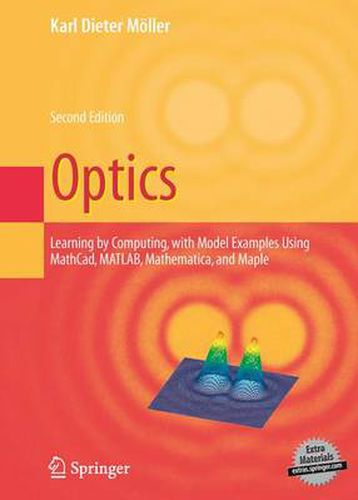Readings Newsletter
Become a Readings Member to make your shopping experience even easier.
Sign in or sign up for free!
You’re not far away from qualifying for FREE standard shipping within Australia
You’ve qualified for FREE standard shipping within Australia
The cart is loading…






This new edition is intended for a one semester course in optics for juniors and seniors in science and engineering; it uses scripts from Maple, MathCad, Mathematica, and MATLAB provide a simulated laboratory where students can learn by exploration and discovery instead of passive absorption. The text covers all the standard topics of a traditional optics course, including: geometrical optics and aberration, interference and diffraction, coherence, Maxwell’s equations, wave guides and propagating modes, blackbody radiation, atomic emission and lasers, optical properties of materials, Fourier transforms and FT spectroscopy, image formation, and holography. It contains step by step derivations of all basic formulas in geometrical, wave and Fourier optics. The basic text is supplemented by over 170 files in Maple, MathCad, Mathematica, and MATLAB (many of which are in the text; al scripts are included on the CD), each suggesting programs to solve a particular problem, and each linked to a topic in or application of optics. The computer files are dynamic, allowing the reader to see instantly the effects of changing parameters in the equations. Students are thus encouraged to ask What if? questions to asses the physical implications of the formulas. The discussion of Fourier transforms in particular is enhanced by the availability of numerical methods. The book is written for the study of particular projects but can easily be adapted to other situations. The threefold arrangement of text, applications, and files makes the book suitable for self-learning by scientists or engineers who would like to refresh their knowledge of optics.In the classroom, the Maple, MathCad, Mathematica, and MATLAB scripts can serve as starting points for homework; outside, they can help find solutions to complex problems in engineering applications.
$9.00 standard shipping within Australia
FREE standard shipping within Australia for orders over $100.00
Express & International shipping calculated at checkout
This new edition is intended for a one semester course in optics for juniors and seniors in science and engineering; it uses scripts from Maple, MathCad, Mathematica, and MATLAB provide a simulated laboratory where students can learn by exploration and discovery instead of passive absorption. The text covers all the standard topics of a traditional optics course, including: geometrical optics and aberration, interference and diffraction, coherence, Maxwell’s equations, wave guides and propagating modes, blackbody radiation, atomic emission and lasers, optical properties of materials, Fourier transforms and FT spectroscopy, image formation, and holography. It contains step by step derivations of all basic formulas in geometrical, wave and Fourier optics. The basic text is supplemented by over 170 files in Maple, MathCad, Mathematica, and MATLAB (many of which are in the text; al scripts are included on the CD), each suggesting programs to solve a particular problem, and each linked to a topic in or application of optics. The computer files are dynamic, allowing the reader to see instantly the effects of changing parameters in the equations. Students are thus encouraged to ask What if? questions to asses the physical implications of the formulas. The discussion of Fourier transforms in particular is enhanced by the availability of numerical methods. The book is written for the study of particular projects but can easily be adapted to other situations. The threefold arrangement of text, applications, and files makes the book suitable for self-learning by scientists or engineers who would like to refresh their knowledge of optics.In the classroom, the Maple, MathCad, Mathematica, and MATLAB scripts can serve as starting points for homework; outside, they can help find solutions to complex problems in engineering applications.